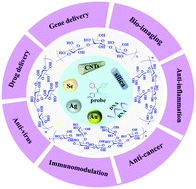Progress in rigid polysaccharide-based nanocomposites with therapeutic functions
Abstract
Polysaccharides are naturally occurring biological macromolecules that are envisaged as promising substitutes of non-degradable polymers due to their outstanding inherent properties of biodegradability, biocompatibility, low-cost, and availability. Their utilization in the development of nanostructured hybrid materials has numerous advantages in theranostics, the integrated approach of therapeutics and diagnostics. In particular, some rigid polysaccharides occur in nature, which can self-assemble into ordered hierarchical structures, facilitating the controllable fabrication of various nanocomposites. These rigid polysaccharides, including Lentinan, Curdlan, Schizophyllan, Scleroglucan, Auricularian, and yeast glucan, possess the linear β-(1→3)-D-glucan as the backbone with or without β-(1→6)-linked glucose as the branch, having diverse biological activities. This review focuses on the incorporation of nanoparticles, such as gold (AuNPs), silver (AgNPs), selenium (SeNPs), silica, carbon nanotubes, homo-polynucleotides, bio-imaging probes, and drugs, into different rigid polysaccharide matrices through self-assembly and summarizes their biological functions as well as the correlation to their conformations. Additionally, we addressed the use of the as-engineered polysaccharide nanocomposites as effective therapeutic agents, and the challenges or ambiguity issues concerning further practical clinic therapeutic applications.

- This article is part of the themed collection: Recent Review Articles


 Please wait while we load your content...
Please wait while we load your content...